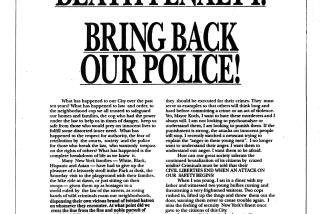Community Essay : ‘It’s Unfair to Criticize Verdicts’ : By judging their peers, Teen Court students learned how real juries function.
On April 26, Teen Court debuted at Los Angeles’ Wilson High School. The El Sereno neighborhood school was selected because of its Administration of Justice and Law Magnet Program, which provided a natural and appropriate setting for this innovative idea that offers first-time offenders charged with misdemeanors an opportunity to be judged by a jury of their peers.
The program also provides an invaluable learning experience for the students who have already selected law as their field of study; they act as the jurors and have demonstrated not only enthusiasm but a keen sense of responsibility. Their questions to the accused are thoughtful and penetrating. (There are no lawyers in Teen Court, so the jurors are allowed to ask questions). And they have proven to be fair but firm in their recommendations for sentencing, recommendations that I, sitting as judge, generally follow and so order. These are real cases, and the minor who opts for Teen Court must abide by the orders and conditions that I impose.
On Oct. 19, the Wilson High School Teen Court participants learned a valuable civic lesson, one that the American public desperately needs to learn, too. On that day, fortuitously, all of the verdicts were announced in the Reginald Denny beating case and the public seemed to be in a state of disbelief over the results. Many people could not understand how the jury could have come up with those verdicts.
Speculation abounded that the jury chose “peace over justice” and that justice system had failed once again. Well, the lesson learned by the Teen Court students/jurors is that the jury system does work. It had been proven to them very graphically in a case they heard that day. We had just finished hearing the evidence in a graffiti case and I had instructed the jury for its deliberations and had excused them for that purpose. I then took a poll of the remaining panel of students/jurors who comprised the audience. Three voted for guilty and the rest of them, about 18 or 19, voted for not guilty. I was asked how I felt and I also said “Not guilty.”
The jurors returned with their decision about 20 minutes later, and the audience was stunned when jurors announced that they had found the accused guilty.
What they learned is that while the audience was present during the entire case and heard all of the evidence, they did not have the benefit of discussing it among themselves before they were asked to vote. Their vote was almost a knee-jerk reaction to what they had just seen and heard, just like most of the public that had the videotape of the Denny beating engraved in their minds when they formed their opinions long before those verdicts came down.
This appears to be what happened in the case of alternate Juror 188 in the Denny case. She publicly criticized the jury for its verdicts. But as the attorney for one of the defendants, Edi M. O. Faal, pointed out after a discussion with the jurors after their verdicts, “Some of the jurors went into the deliberations agreeing with the statements Juror 188 made, but they changed in the deliberation process.” This is exactly what the jury system is all about. One who did not participate cannot criticize any jury because only they know what was discussed and considered in reaching their decision.
Juror 188, then, is not unlike the Wilson High School students who heard the case while in the audience. However, most of the public did not see and hear every bit of evidence in the Denny beating trial and simply relied on media reports on how the case was progressing. They did not have the benefit of the instructions by the judge on the law and, most importantly, they did not have the responsibility of discussing and deciding the facts and applying the law as required in fulfilling their obligations as jurors. Only by diligently having open and frank discussions about their respective points of view with each other and an open mind with a willingness to change an opinion can the jury system work. There is nothing to suggest that these jurors did not take their charge seriously and, therefore, it is grossly unfair for the public to criticize their verdicts.
In the final analysis, what we have are three separate groups of people who comprise the general public: the jurors who have taken an oath of responsibility to sit in judgment on a fellow man; the alternates and others who were present throughout the entire process and had the benefit of listening to and seeing every bit of evidence and also hearing the judge’s instructions on the law, and the rest of us, who only had the benefit of the media reports. Of the three groups, only the actual jurors know why and how they arrived at their verdicts. From our perspective, the verdicts may seem unfair, hence the lesson of Teen Court for the fortunate students at Wilson High who were able to experience it firsthand and hopefully will not be so quick to second-guess a jury in the future. Let’s hope that the public profits by this lesson as well and that the media--especially--are careful not to fuel the emotions of those who do not fully understand how our jury system works because, while not perfect, it is the best system in the world.
More to Read
Sign up for Essential California
The most important California stories and recommendations in your inbox every morning.
You may occasionally receive promotional content from the Los Angeles Times.










